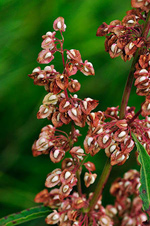|
||||||
|
RUMEX. Docks and Sorrel. [Polygonaceae] |
|
|
Thirteen species and numerous hybrids of Rumex are recorded as native to Britain. These include Common Sorrel (R. acetosa), Curled Dock (R. crispus), Water Dock (R. hydrolapathum), Northern Dock (R. longifolius) and Broad-leaved Dock (R. obtusifolius). Shore Dock (R. rupestris) is protected under Schedule 8 of the Wildlife and Countryside Act, 1981. Seven British miners are recorded on Rumex. The scathophagid Norellisoma spinimana is a stem-borer on Rumex. The moth Coleophora hydrolapathella is recorded feeding in the seeds of Rumex hydrolapathum (see British leafminers). A key to the European miners recorded on Rumex is provided in Bladmineerders van Europa. |
|
|
Note: Diptera larvae may live in a corridor mine, a corridor-blotch mine, or a blotch mine, but never in a case, a rolled or folded leaf, a tentiform mine or sandwiched between two more or less circular leaf sections in later instars. Pupation never in a cocoon. All mining Diptera larvae are leg-less maggots without a head capsule (see examples). They never have thoracic or abdominal legs. They do not have chewing mouthparts, although they do have a characteristic cephalo-pharyngeal skeleton (see examples), usually visible internally through the body wall. The larvae lie on their sides within the mine and use their pick-like mouthparts to feed on plant tissue. In some corridor miners frass may lie in two rows on alternate sides of the mine. In order to vacate the mine the fully grown larva cuts an exit slit, which is usually semi-circular (see Liriomyza huidobrensis video). The pupa is formed within the hardened last larval skin or puparium and as a result sheaths enclosing head appendages, wings and legs are Rudbeckia. Widespread throughout Britain. Also recorded in the Republic of Ireland. Widespread in continental Europe. |
Liriomyza strigata (Meigen, 1830) [Diptera: Agromyzidae]. |
1b > Leaf-miner: Mine not primarily above mid-rib. |
| 2 > Leaf-miner: Mine linear, whitish, both upper and lower surface. Pupation internal, at the end of the mine with the anterior spiracles projecting through the epidermis (Spencer, 1976: 433). Upper-surface, less often lower-surface corridor. Frass in isolated grains. Pupation within the mine, in a, usually lower-surface, pupal chamber. A long whitish upper surface corridor, which eventually goes lower surface. |
|
Chromatomyia
horticola (Goureau, 1851) [Diptera: Agromyzidae] |
| Last updated 07-Jul-2019 Brian Pitkin | ||

